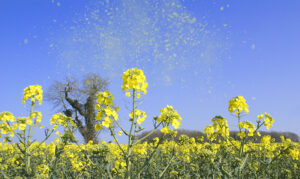Allergy? Blame the Pollen. But What is Pollen?
By Eva Briggs, M.D.

It’s been a banner year so far for seasonal allergies. The major culprit is pollen.
What exactly is this stuff called pollen?
This powdery substance produced by flowering plants contains the male reproductive cells. Each pollen grain has a hard protective coat enclosing a gametophyte (a cell that can become a sperm cell) plus one or more nonreproductive “vegetative” cells.
When a pollen grain lands on a compatible female flower or cone it germinates.
The vegetative cell(s) forms a tube that leads into the female flower. The gametophyte splits to form two sperm cells that travel down the pollen tube to fertilize the female ovule. Of course, the pollen somehow has to get from one plant to another.
Entomophilus pollen travels by adhering to an insect who moves it along. This type of pollen sticky, protein rich, and relatively heavy. It’s often visible. But entomophilus pollen generally is not the type of pollen to trigger allergies because the heavy grains fall on the ground rather that traveling on the wind to people’s noses and eyes.
Anemophilus pollen, on the other hand, is tiny and disperses when blown about by the wind. Plants with airborne pollen must produce vast quantities of pollen to ensure that it wafts through the air and successfully drifts onto an appropriate female flower. These tiny pollen grains, invisible to the naked eye, trigger allergies by landing in a susceptible person’s nose or eyes.
There’s actually an entire scientific field called palynology devoted to the study of pollen. Microscopic examination of pollen is used in fields such as dating sediments and forensics. As a forestry student I learned to identify several types of tree pollen via microscope. All I remember is pine pollen, whose grains have two tiny airbladders to prolong their airtime but make them resemble tiny Mickey Mouse heads when viewed under the microscope.
Tree pollen usually disperses in early spring, often before plants turn green. Grass pollen season starts in later spring and continues into the summer. Weed pollen usually kicks in during spring and extends into the fall. A major source of allergy-inducing pollen is ragweed which starts in August and continues to November.
Tree and grass pollen counts are highest in the evening. Weed pollen counts peak in the morning. Rain washes pollen out of the air. But after the rain ends plants may release a burst of pollen making the counts climb.
On calm days pollen drifts to the ground but windy days blow the pollen around.
So, what should a pollen allergy sufferer do?
• Step one is avoidance when possible: monitor pollen counts and stay indoors during high levels. Keep your house and car windows shut during allergy season. After spending time outdoors change your clothes, shower and wash your hair. This is also a great time to check for ticks. Wearing an N95 or KN95 face mask can help filter out pollen when counts are high or during activities like lawn mowing.
• Step two is using over-the-counter medicines to control symptoms. If you know when your allergies start, these medicines can be started one or two weeks prior to allergy symptoms. Oral medicines include antihistamines: cetirizine, fexofenadine, levocetirizine and loratadine cause less drowsiness than diphenhydramine. Over-the-counter eye drops for treating allergies include ketotifen and olopatadine. Also helpful are steroid nose drops such as fluticasone, budesonide, and triamcinolone. If needed you can use an oral medicine, eye drops, and nose sprays in combination. Because there are so many commercial brands, I have used the generic names. If you are not sure what is in a particular medicine, consult the pharmacist or your medical provider.
If avoidance and over-the-counter medicines don’t help, the next step is seeing your doctor. They can determine whether prescription medicines, allergy testing, and/or immunotherapy (allergy shots or drops) are needed,

